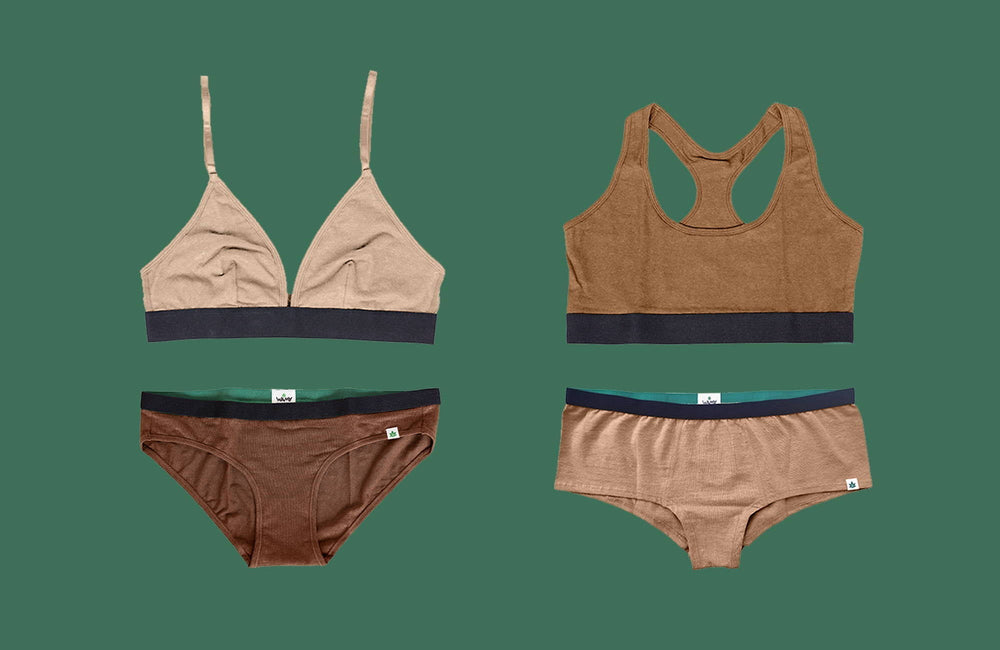
What Color Is Nude? Here's The Truth
|
If you're not happy with your first pair of underwear after trying it on, let us know.
We'll send a new size or color, or give you a refund. No returns needed.

Paulina Kwik
|
It’s not the 1950s anymore, so seriously, what color is nude? If you’re shopping for high waisted underwear , for example, what nude color options do you have? It’s frustrating if you can’t find the shade that fits you, so if the color nude is a skin tone, I think we can all agree that it can’t just be beige.
Although the fashion industry has had a hold on the definition of nude, you’ll be happy to know that things are shifting—at WAMA, too! WAMA is launching four new nude shades, and I’m here for it. I mean, if sustainable fabrics using low impact dyes can offer a range of nude color options, then anyone can! I’ve got the serious scoop on what the color nude truly is, WAMA’s new shades, and why diversity in fashion is so important.
In the fashion world, the color nude describes an all-over tone that mixes brown and white. It was originally named for Western-European-centric Caucasian skin—no surprise there, right? And through the 1920s and 1930s, you could find “nude” in women’s underwear styles , only complementing white skin. Today, although skin tones come in far more than one shade, “nude” still describes skin tone in general, despite not being an inclusive shade.
According to Color Psychology , a nude color has several attributes when used in fashion, beauty, home decor, and anywhere else:
You’d think such a warm and sophisticated color wouldn’t be so racist, but words like warm, sophisticated, modest, and feminine can describe anyone with any skin tone. So if you’re ready for a bit of diversity in the color nude, well, you kinda have Michelle Obama to thank—seriously!
In 2009, First Lady Michelle Obama wore a stunning dress to a state dinner, which the media described as nude . But since it didn’t fit her skin tone, everyone started to wonder if it was really nude and if the color perpetuated racism. Samantha Critchell from the Associated Press famously described Obama’s dress as “silver-sequined, flesh-colored.” For the record, this dress did not match the famous wearer’s skin tone, so it certainly couldn’t be described as “flesh-colored” for anyone with darker skin tones.
You could consider this the “dress seen around the world,” causing a big spark in the conversation about adding more diversity to nude shades in fashion and elsewhere. If you remember this dress, then maybe you also remember people asking about flesh-colored underwear, shoes, tights, and even Band-Aids.
A few interesting things happened in the aftermath of The Dress:
These singular actions involving the question of what color is nude have slowly evolved into a much larger conversation about diversity in skin tones, especially in the fashion and beauty industries. No doubt you’ve heard about Rihanna’s Fenty beauty line and Kim K’s shapewear, right? As a consensus of these brands, the color nude can’t possibly represent every person’s flesh when it’s just one pale color.
In 2019, the census reported 13.4% of Americans were Black. Nearly 6% were Asian, over 18% were Hispanic, and about 1.5% were American Indian, Alaskan Native, Native Hawaiin, or Pacific Islander. If you haven’t had your coffee yet today, that’s over 40% of our population boasting gorgeous non-“nude” nude skin tones, which is predicted to pass 50% by the year 2044 .
And since we’re all human, that same 40% go shopping and may want flesh-colored goods that match their skin tones. So today, you can find several brands offering more and more inclusivity in the color nude.
Fenty Beauty, started by Rihanna, took inclusivity to a new level. So what color is nude for Fenty? The color nude literally comes in 40 different shades—hello, diversity! If you’re wondering if shoppers want more variety in beauty and fashion, Fenty made over $72 million in their very first month . I had no idea if that’s good or not, but it turns out it’s over 5x more than any of its competitors. Wow, okay, I think the people have spoken.
If you have a darker skin tone and have tried to buy makeup from Fenty, you may have noticed that it’s often sold out despite constant restocking. I think this shows how in-demand various products are, and many other beauty brands are following suit. This is actually called the “Fenty Effect!” Way to go, Bad Gal RiRi!
If you can forget the mistake of initially naming her product “kimono” and attempting to trademark the word, Kim Kardashian’s SKIMS shapewear is all about diversity inclusion. Fun fact: Kim once made her own shapewear by dyeing it with tea bags to match her skin tone. If a billionaire Kardashian, who could probably buy her own private island, can’t find shapewear that matches her skin tone, something’s not right.
SKIMS shapewear offers seven different shades of nude color, and, much like Fenty, the darker shades tend to be low in stock. As for sizes, SKIMS sells XXS to 5XL, so not only are they diverse in what is nude color, but they’re also inclusive in sizing.
One of the reasons Band-Aid bandages come in the color nude is to hide the plaster on your body. But what if your body isn’t the one shade of nude color that they sell? Thank you, Michelle, thank you, RiRi because now Band-Aid has launched bandages in different skin tones! It’s great, but it took them nearly 100 years.
Band-Aid started in 1921 with its one shade of “flesh” color, completely leaving out all the Americans with darker skin tones. Their new line featuring five nude color options launched in 2020. The change came in response to the Black Lives Matter movement .
This change is influential because it’s with such a huge company with a lot of in-store real estate. But if you’re declaring Band-Aid was too-little-too-late (I don’t blame you!), you can always support the brand Tru-Colour, which launched inclusive bandages in 2014. Tru-Colour pushes that “diversity isn’t a trend,” but Fenty basically made it a business model. Hopefully, some good will come out of it, and more brands will see the light for genuine reasons.
Despite ballet and dance apparel lacking diversity, dancers are usually required to wear tights and shoes that match their skin tone, which means non-white dancers spend time “pancaking” their gear. This tactic requires hours of sponging their apparel with makeup to match their skin tones. In 2016, Gaynor Minden, a large US retailer of dance apparel, finally offered three nude color options for darker skin tones.
The company said they wanted to sell more diverse apparel since 1986 but didn’t until public pressure made it cost-effective. Sigh. Still, it has caused a shift, and now many brands offer diversity in the color nude, including Freed of London, one of the biggest retailers of dance shoes.
Because WAMA also believes in representation and diversity, the pioneer of hemp underwear is launching a new line of nude underwear, which features four shades of the color nude—whoop! Of course, you can still get classic black, WAMA green, and hemp colors, but now you can also choose from four nude colors to better match your skin tone!
When shopping for your favorite weed underwear you can choose from the colors Nude 1, Nude 2, Nude 3, and Nude 4. What is nude color for WAMA? The numbers get higher as the shade darkens, so you can find the shade that best matches your natural skin tone. I’ll still lovingly wear my black high waisted underwear and hemp bra from WAMA, but I appreciate that this first nude line comes in four different shades, so I’m also a bit pumped!
When I think about WAMA and ask the question, What is nude color?, it totally makes sense for hemp underwear to be inclusive. Hemp fabric is already one of the most sustainable natural materials on the planet, meaning it’s good for humans and the environment. It’s only natural for WAMA to also make people feel good by offering several shades of the color nude. WAMA wants to provide a superb pair of underwear that’s good for the body, the planet, the people making your clothes, and you—underwear that works for everyone, regardless of race or skin color.
Nude is not just one color, and WAMA knows that. With four shades of nude underwear, you can now feel even more comfortable in durable, super soft, breathable underwear . Yea, I didn’t think that was possible either, but yay for offering four shades on the first nude underwear launch!
Shout out to Michelle Obama and Rihanna for getting the ball rolling, and thanks to all the other brands following suit. I know it can feel like a marketing gimmick for some companies, and they have a long way to go, but I think the fashion world is turning a slight corner in terms of diversity.
So which color will you choose? I’m pasty, so I gotta go with Nude 1. Lemme know your shade in the comments!
Get updates on restocks, new color and size releases, and upcoming product launches. You’ll also get a 15% discount on your first order of hemp underwear.












